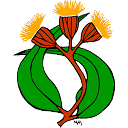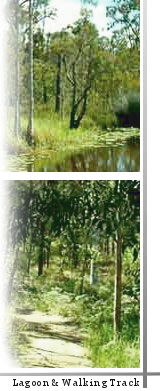|
HISTORY
A variety of topography ranging from rocky outcrops containing sheltering caves to a fertile lagoon
system known as Half Moon Lagoons, made the Karawatha region a popular place for indigenous people to hunt and
fish. With European settlement these features were incorporated into the lifestyle of the early pioneers.

Karawatha Forest and Aboriginal Peoples
The following information on Aboriginal history was provided by noted Aboriginal author Melissa
Lucashenko, melissalucashenko.com.au. It was researched by
Ms Lucashenko in consultation with Uncle Des Sandy who is the senior Elder for the Yuggera nation, also with the
Logan Elders Group and Aunty Eileen Williams. Yuggera and Jagera are understood to be the same word, spelt
differently by various white interpreters. Current usage of Yuggera is preferred.
 "Karawatha forest is on Yuggera land, and Yuggera people still live near and are connected to the
forest today. The Logan area surrounding Karawatha Forest is also home today to Aboriginal people of many other
neighbouring clans and nations. These include the Gold Coast's Yugambeh, the Muninjali of the greater Beaudesert
area, the Noonuccal/Ngugi of Moreton Bay, and many mobs from further afield, such as the Gunggari of south-western
Queensland and the Ugarapul of the Boonah district, to name but a few.
"Karawatha forest is on Yuggera land, and Yuggera people still live near and are connected to the
forest today. The Logan area surrounding Karawatha Forest is also home today to Aboriginal people of many other
neighbouring clans and nations. These include the Gold Coast's Yugambeh, the Muninjali of the greater Beaudesert
area, the Noonuccal/Ngugi of Moreton Bay, and many mobs from further afield, such as the Gunggari of south-western
Queensland and the Ugarapul of the Boonah district, to name but a few.
"In Aboriginal culture, people other than traditional owners visit or pass through other's
territory only with permission. Before white contact, many Aboriginal peoples travelling the ancient tracks which
later became Logan Road would have passed close to the forest area, and probably camped within it as guests of the
Yuggera. The rich environment would have been carefully managed by Yuggera people with fire to provide abundant
food such as wallaby, goanna, snake, fish, lobsters and possum for meat. Honey, yams, berries and other healthy
bush tucker would also have been skilfully cultivated. Yugambeh and Bundjalung people from as far south as
Grafton would have moved through the Forest area regularly, and especially on their way to the three-yearly Bunya
Festival held in the Bunya mountains, along with other southern clans.
"With the arrival of Europeans in the mid-1800s, Aboriginal life was severely disrupted.
Traditional Indigenous management of the Forest would have been invisible to Europeans, who quickly dispossessed the
traditional owners. Despite this history of dispossession, Yuggera and other Aboriginal people still know, use
and love Karawatha Forest today. Theirs is a living culture, and caring for the environment is central to
it."

European Settlement
With European settlement the early pioneers used the lagoons as a permanent source of water for
sustenance, stock watering, and recreation.
 A productive timber industry existed in the area from the mid 1850's to the late 1950's. Great
forest giants were removed for firewood and housing. The adjoining suburb of Woodridge gets its name from the
heavily timbered ridges, which existed in this area. With the outbreak of WWII, Karawatha was further exploited
of much of its timber, which was used instead of coal in the coal fired train engines. A quarry, which removed
part of the rocky outcrop known as Alice's Rocks, was constructed in the late 1960's completely destroying a system of
caves.
A productive timber industry existed in the area from the mid 1850's to the late 1950's. Great
forest giants were removed for firewood and housing. The adjoining suburb of Woodridge gets its name from the
heavily timbered ridges, which existed in this area. With the outbreak of WWII, Karawatha was further exploited
of much of its timber, which was used instead of coal in the coal fired train engines. A quarry, which removed
part of the rocky outcrop known as Alice's Rocks, was constructed in the late 1960's completely destroying a system of
caves.
In the 1950's and 1960's, urbanisation began to spread to the outer suburbs swallowing up much of the
fertile farmland. By the 1970's, environmental values began to gain attention as the global threat was
identified.
The urban sprawl finally reached the Karawatha area in the early 1980's. Some attempts were made
within the Brisbane City Council at this time to protect some of this area but these were unsuccessful. By 1990,
the community realised that the bush, which everyone had taken for granted, would soon completely disappear.


 Karawatha Forest Protection Society Inc
Karawatha Forest Protection Society Inc
In 1990, three ladies familiar with this bushland decided to lobby the Brisbane City Council to save the
bushland from development.
In 1991 the Karawatha Forest Protection Society Inc (KFPSI) was formed and incorporated in response to
the groundswell of public opinion. The Brisbane City Council introduced a Bushland Levy in the same year which
made the purchase of significant lands possible. The State Government also made valuable contributions to the
size of the forest. Because of its strategic importance, Council has dedicated some adjoining lands to become
part of Karawatha Forest and surrounding areas such as the Kuraby Bushland. The Forest will be further enhanced
through the protection of natural corridors and addition of land through the Bushland Levy.
Karawatha Forest is now managed by the Brisbane City Council with guidance from a management plan which
was set up with community consultation. This stipulated that the Forest be used for conservation and for passive
recreation purposes.
The Society continues to follow the aims of its Rules of Incorporation to protect and to champion the
Karawatha Forest. Please refer to our Society's Mission Statement.

|




